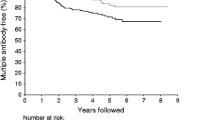Summary
To study the relationship of IA-2 antibodies (IA-2A) to other autoantibodies and genetic risk markers in insulin-dependent diabetes mellitus (IDDM), 758 children and adolescents younger than 15 years of age (mean age 8.4 years) with newly diagnosed diabetes were analysed for IA-2A, GAD antibodies (GADA) and insulin autoantibodies (IAA) with radiobinding assays, for islet cell antibodies (ICA) with immunofluorescence and for HLA DR alleles by serology. IA-2A were detected in 85.9 % of cases with no association with gender or age. An overwhelming majority of the patients (71.3 %) tested positive for three or more antibodies, and 90.7 % for at least two. Fifty-four subjects (7.1 %) had one antibody detectable, whereas only 2.1 % of the patients tested negative for all four. A higher proportion of patients was positive for IA-2A and/or GADA than for ICA alone (95.5 vs 84.2 %, p < 0.001). The prevalence and level of IA-2A were increased in cases carrying HLA DR4/non-DR3 compared with other DR combinations. The results indicate that almost all patients with newly diagnosed childhood IDDM can be identified by screening with these four autoantibodies. The combination of IA-2A and/or GADA had a higher sensitivity for IDDM than ICA alone. The close association between IA-2A and HLA DR4, the strongest single allele predisposing to IDDM, suggests that IA-2A may be a more specific marker of beta-cell destruction than GADA, which have been shown to associate with the DR3 allele and thyroid autoimmunity. [Diabetologia (1998) 41: 424–429]
Article PDF
Similar content being viewed by others
Avoid common mistakes on your manuscript.
Author information
Authors and Affiliations
Consortia
Additional information
Received: 20 August 1997 and in final revised form: 13 November 1997
Rights and permissions
About this article
Cite this article
Savola, K., Bonifacio, E., Sabbah, E. et al. IA-2 antibodies – a sensitive marker of IDDM with clinical onset in childhood and adolescence. Diabetologia 41, 424–429 (1998). https://doi.org/10.1007/s001250050925
Issue Date:
DOI: https://doi.org/10.1007/s001250050925




